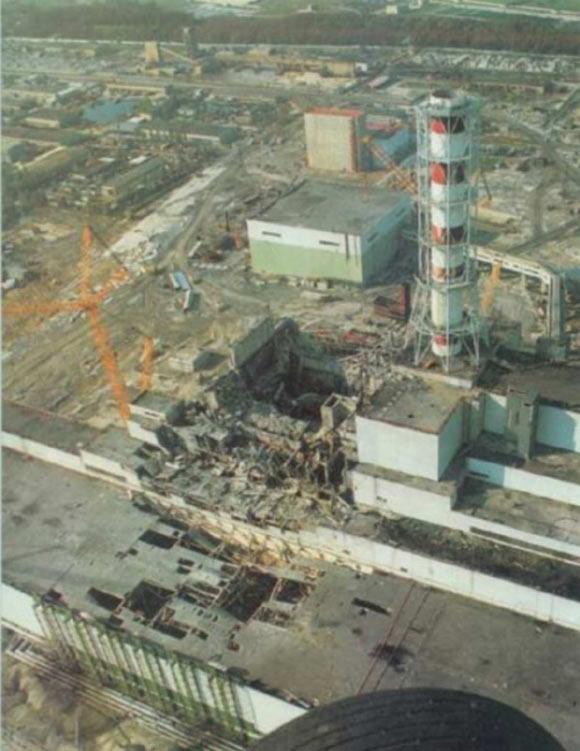According to an analysis published in the journal Nuclear Technology, the first of the two major explosions reported by eyewitnesses of the Chernobyl disaster was a nuclear and not a steam explosion.

Chernobyl disaster aftermath: reactor 4 (center), turbine building (lower left) and reactor 3 (center right).
“Numerous studies have been carried out of the 1986 disaster at the Chernobyl-4 reactor in Ukraine. Many of them have dealt with health effects and the dispersion of radioactive nuclides and contamination of vast areas of land, primarily in Europe,” said lead author Dr. Lars-Erik De Geer, a retired nuclear physicist from the Swedish Defence Research Agency, and colleagues.
“But, there has also been great interest in how the accident proceeded during a few seconds around 01:23:45 local time on April 26, 1986.”
“It appears clear from several witnesses that there were two major explosions, the second, and largest, occurring a couple of seconds after the first.”
“The first one is widely believed to have been a steam or vapor explosion where the energy in the hot cooling water together with the energy generated by a nuclear surge across the reactor core pressurized the steam so much that the reactor ruptured in an explosive way. The next explosion has been described as a hydrogen explosion where hydrogen, produced by exothermic reactions between zirconium in the fuel cladding and water/steam, soon burned explosively with oxygen in the air.”
According to Dr. De Geer and co-authors, the first explosive event at Chernobyl was actually a jet of debris ejected to very high altitudes by a series of nuclear explosions within the reactor. This was followed, within three seconds, by a steam explosion which ruptured the reactor and sent further debris into the atmosphere at lower altitudes.
The theory is based on new analysis of xenon isotopes detected by scientists from the V.G. Khlopin Radium Institute in Leningrad, four days after the accident, at Cherepovets, a city north of Moscow far from the major track of Chernobyl debris.
These isotopes were the product of recent nuclear fission, suggesting they could be the result of a recent nuclear explosion.
In contrast, the main Chernobyl debris which tracked northwest to Scandinavia contained equilibrium xenon isotopes from the reactor’s core.
By assessing the weather conditions across the region at the time, the physicists also established that the fresh xenon isotopes at Cherepovets were the result of debris injected into far higher altitudes than the debris from the reactor rupture which drifted towards Scandinavia.
Observations of the destroyed reactor tank indicated that the first explosion caused temperatures high enough to melt a two-meter thick bottom plate in part of the core. Such damage is consistent with a nuclear explosion.
In the rest of the core, the bottom plate was relatively intact, though it had dropped by nearly four meters. This suggests a steam explosion which did not create temperatures high enough to melt the plate but generated sufficient pressure to push it down.
“We believe that thermal neutron mediated nuclear explosions at the bottom of a number of fuel channels in the reactor caused a jet of debris to shoot upwards through the refueling tubes,” Dr. De Geer said.
“This jet then rammed the tubes’ 350 kg plugs, continued through the roof and traveled into the atmosphere to altitudes of 2.5-3 km where the weather conditions provided a route to Cherepovets.”
“The steam explosion which ruptured the reactor vessel occurred some 2.7 seconds later.”
Seismic measurements and an eye-witness report of a blue flash above the reactor a few seconds after the first explosion also support the new hypothesis of a nuclear explosion followed by a steam explosion.
This new analysis brings insight into the disaster, and may potentially prove useful in preventing future similar incidents from occurring.
_____
Lars-Erik De Geer et al. A Nuclear Jet at Chernobyl around 21:23:45 UTC on April 25, 1986. Nuclear Technology, published online November 16, 2017; doi: 10.1080/00295450.2017.1384269







